#cvn 75
Explore tagged Tumblr posts
Text
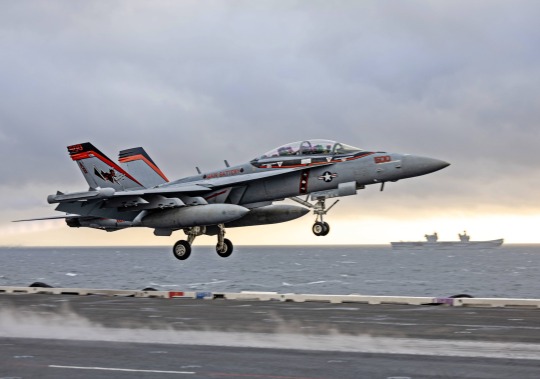
An EA-18G Growler lands on the deck of USS Harry S. Truman (CVN-75), with HMS Prince of Wales (R09) visible in the background.
79 notes
·
View notes
Text
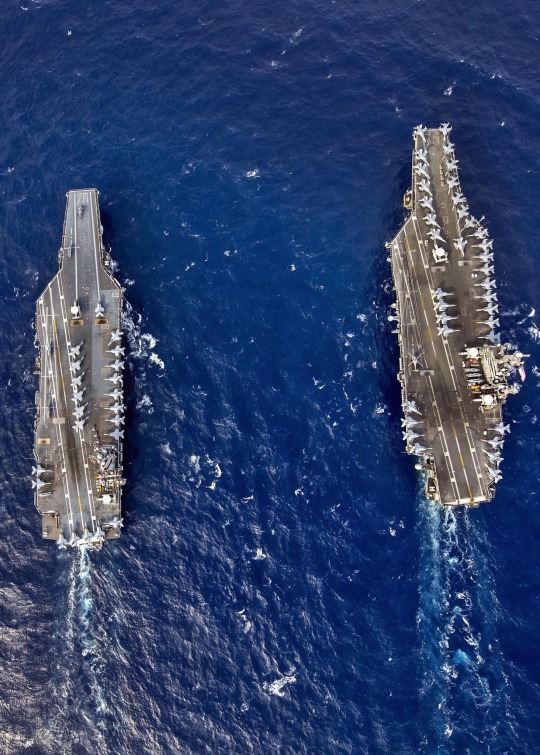
USS Gerald R. Ford (CVN-78) and USS Harry S. Truman (CVN-75) transit the Atlantic Ocean, marking the first time a Ford-class and a Nimitz-class aircraft carrier operated together underway, 4 June 2020.
88 notes
·
View notes
Text

The Nimitz class aircraft carrier USS Harry S. Truman (CVN-75) making her way down the Elizabeth River after departing the Norfolk Naval Shipyard.
For a ship the size of a supercarrier, navigating the river is no small feat. A cloud of silt can be seen behind the carrier, stirred up by her massive screws. Tugs maintain close formation around the carrier, ready to step in if needed.
After navigating the river, the carrier will return to her base at Naval Station Norfolk at Hampton Roads.
At the top of the photo, the stern and upperworks of the Iowa class battleship USS Wisconsin (BB-64) can be seen.
54 notes
·
View notes
Text

Without the CMV-22, the U.S. Navy needs 15 former C-2A to carry out missions aboard the aircraft carriers
Fernando Valduga By Fernando Valduga 02/20/2024 - 20:58in Military
The uncertainty of the return of the tiltrotor V-22 to full operation is leading the U.S. Navy to rethink its plans on how to refuel its aircraft carrier fleet in the short term, with more uncertainty in the long term, and the remaining C-2A Greyhounds become essential.
The service had initially planned to retire its remaining 15 C-2A Greyhound onboard delivery (COD) aircraft in the next two years and replace them with a total of 38 CMV-22B Ospreys, which DOT&E reported "not to be operationally adequate".
“For the luck of the Navy, the C-2 Greyhound is still available,” said Vice Admiral Air Boss Daniel Cheever at a panel at the WEST 2024 conference, co-organized by the U.S. Naval Institute and the AFCEA. "Limited operational impacts at this time, but there are still operational impacts. And when you look to the future, there are significant operational impacts."

As part of the Greyhounds' planned retirement, the U.S. Navy stopped training new C-2 pilots and began to reduce spare parts and logistical support for the 60-year project.
This transition, completed on the West Coast, is now paralyzed with the grounding of the V-22 in the U.S. Marines, Navy and Air Force after the fall of a USAF Special Operations MV-22 off the coast of Japan late last year.
The grounding of the Ospreys has already been out of operation for 75 days, with no indication of how long the grounding can continue.

CMV-22B Osprey.
The suspension of operation of the tiltrotors forced the U.S. Navy to exchange the V-22 aboard the West Coast aircraft carriers USS Carl Vinson (CVN-70) and USS Theodore Roosevelt (CVN-71) for the C-2As of the East Coast Fleet Logistics Support Squadron (VRC) 40, the "Rawhides".
"The VRC-40 is currently emerging to fulfill the mission [COD] for aircraft carriers deployed in the 5ª and 7ª U.S. Fleets," says a statement from the Naval Air Forces. "There was no change in the planned retirement of C-2A for 2026."
Although there is still no change in the plan for the C-2, there is little indication of any of the forces for how long the V-22 will be able to remain out of service. After the initial grounding of the fleet, there was very limited information about the underlying cause of the grounding, in addition to a "potential material failure".
For the Marines, the situation is more terrible, said Lieutenant Karsten Heckl during the panel. He said that the operations of the 31ª Marine Expeditionary Unit based in Japan, the 26º MEU deployed in the Bataan Amphibious Ready Group and the 15º MEU that is preparing to be deployed aboard the Boxer ARG had "dramatic impacts".
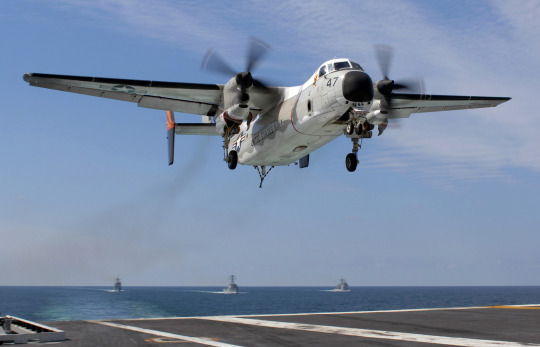
Navy officers said that Marines are allowed to use Ospreys deployed aboard the Bataan ARG in specific emergency situations. A main mission of the 26º MEU, currently deployed in the Eastern Mediterranean, is the evacuation of non-combatants from Lebanon.
Last month, the Assistant Commander of the Marine Corps, General Chris Mahoney, said that the Force risks losing proficiency with the aircraft the longer it stays on the ground.
"At some point, if a pilot does not fly, if a maintainer does not turn a wrench, if an observer or crew chief is not exercising his profession, this will become a matter of competence and then there will be a matter of safety," he said.
Tags: Military AviationCMV-22B OspreyGrumman C-2 GreyhoundUSN - United States Navy/U.S. Navy
Sharing
tweet
Fernando Valduga
Fernando Valduga
Aviation photographer and pilot since 1992, he has participated in several events and air operations, such as Cruzex, AirVenture, Dayton Airshow and FIDAE. He has works published in specialized aviation magazines in Brazil and abroad. He uses Canon equipment during his photographic work in the world of aviation.
Related news
EMBRAER
VIDEO: Embraer and Sierra Nevada demonstrate A-29 Super Tucano for Ghana Air Force
20/02/2024 - 18:08
MILITARY
Leonardo tests new technologies for sustainable flight on C-27J aircraft
20/02/2024 - 15:30
MILITARY
Manufacture of 120 KF-21 Boramae jets for the South Korean Air Force will begin this year
20/02/2024 - 13:30
MILITARY
Air exercise "Spears of Victory" allowed Pakistan to evaluate JF-17 capabilities against Rafale
20/02/2024 - 09:30
MILITARY
Argentine Air Force receives second Embraer ERJ-140LR aircraft to expand its capabilities
20/02/2024 - 08:35
MILITARY
Ukraine claims to have shot down three more Russian jets, totaling six in three days
19/02/2024 - 22:07
12 notes
·
View notes
Text

F-14B (162691/AC112) / VF-32 "Swordsmen"/ USS Harry S. Truman (CVN-75) *Sept2005*
3 notes
·
View notes
Text
I wanna talk about ships and gender. Why?? Idk maybe the fact they are given names of certain gender sometimes? Like remember that time I was like "Nimitz carriers only have male names, but I want them to have some female ships"?. And despite names being male, ships are females mostly irl
Sometimes language affects gender. German, Russian and french, being languages based on gender, have ships as masculine. Yet it has always been tradition for ships to be females.
I wonder how it works in WoC tho. I have some WoC-ified ships that I'd like to share about:-
-> RMS Berengaria, formerly German and later British oceanliner, was originally named Imperator and was referred with "he/him" pronouns. But after being taken by the British, he later became a "she/her". And in my hc, she really didn't have a choice then but to play along.
-> George HW Bush (CVN-77), Theodore Roosevelt (CVN-71), and Harry S Truman (CVN-75) are all females in the Nimitz class, despite that they are named after males.
I'm not sure where to go much with this. I guess in WoC a ship really doesn't have it choice with names. I did once talk about how the assigned name need not be the Ship's real name, due to Flysenhower and Kittyhawk being referred with "The" before their names.
But it's interesting cause like, would all ships have the liberty to change their gender according to their preference or again have the disadvantage of needing to obey their superior companies? For those with built hc, how is the ships supposed to have an alternate name, like who would name them?
11 notes
·
View notes
Text

USS SAN JACINTO (CG-56) maintains a steady course alongside USS HARRY S. TRUMAN (CVN 75) during an early morning Fueling At Sea (FAS). TRUMAN and SAN JACINTO are both enroute to the Persian Gulf to support Operation SOUTHERN WATCH
Photographed by PH2 Aaron J. Lebsack, USN on December 30, 2000.
NARA: 6527638
#USS San Jacinto (CG-56)#USS San Jacinto#Ticonderoga Class#Guided Missile Cruiser#Cruiser#December#2000#united states navy#us navy#navy#usn#u.s. navy#my post
48 notes
·
View notes
Text


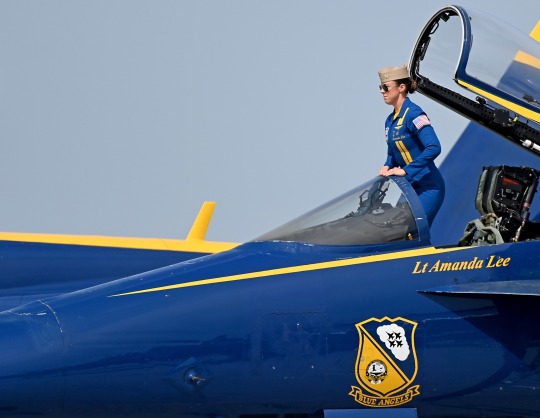

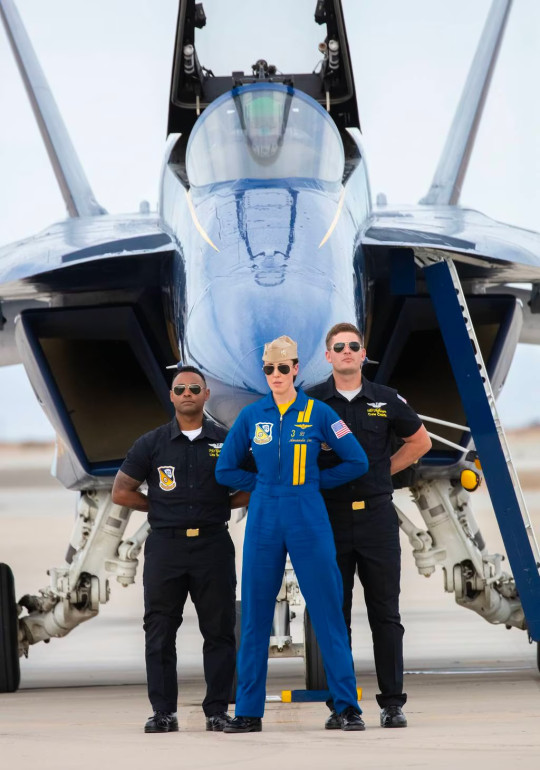





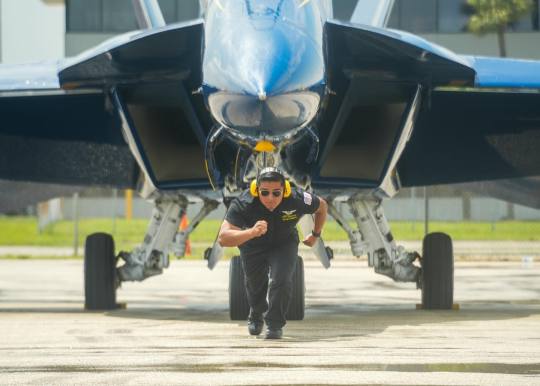

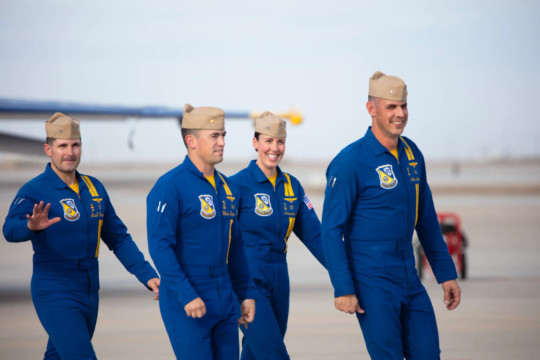
Portrait de femme : La Lieutenante Amanda Lee, première femme pilote de jet de démonstration des célèbres et mythiques "Blue Angels" de l'US Navy.
Le lieutenant Amanda Lee est originaire de Mounds View, Minnesota. Elle est diplômée de l'Irondale High School en 2004, où elle a participé à des compétitions de soccer, de hockey sur glace et de natation. Pendant ses études à l'Université du Minnesota Duluth, Amanda s'est enrôlée dans la marine américaine en tant que technicienne en électronique d'aviation (AT) et a eu son premier commandement avec le Strike Fighter Squadron 136 (VFA-136) "Knighthawks". Elle a été sélectionnée pour sont admission en service en tant que pilote par le biais du Seaman-to-Admiral (STA-21) programme de mise en service en 2009.
L'année suivante, Lee a assisté à la Naval Science Institute (NSI) pour la formation des officiers à Newport, Rhode Island, et a commencé simultanément ses études à Old Dominion University à Norfolk, en Virginie, où elle a obtenu un baccalauréat ès sciences en biochimie. Amanda a obtenu sa commission dans la marine américaine en août 2013 et a fait rapport à la Naval Air Station (NAS) Pensacola, en Floride, pour commencer sa formation de pilote naval.
Elle a suivi l'Aviation Preflight Indoctrinement (API) en Avril 2014 et a terminé la formation de vol primaire en novembre 2014 dans le T-6B Texan II au NAS Whiting Field tout en étant attaché au Training Squadron Two (VT-2) "Doerbirds". Ensuite, elle s'est rendue au NAS Kingsville, au Texas, où elle a terminé sont entraînement en vol intermédiaire et avancé dans le T-45C Goshawk tout en étant attaché au VT-22 "Golden Eagles".
Amanda Lee a été désigné aviateur naval en avril 2016. Après avoir gagné ses ailes d'or, Amanda a été intégré au Strike Fighter Squadron 106 (VFA-106) "Gladiators"a la NAS Oceana à Virginia Beach, Virginie, pour s'entraîner sur le F/A-18 Super Hornet. Sa première affectation à la flotte était avec le Strike Fighter Squadron 81 (VFA-81) "Sunliners" de la NAS Oceana, Virginie, où elle a effectué deux déploiements de combat à bord du porte-avions USS Harry S Truman (CVN-75) soutenant l'opération Inherent Resolve (OIR), l'opération Freedom Sentinel (OFS) et l'exercice Trident Juncture de l'OTAN. Parallèlement au vol, elle a occupé le poste d'officier des horaires, Officier du mess du caf��, officier de la division de ligne et normalisation de la formation et des procédures d'exploitation de l'aéronavale (NATOPS) Officier.
À la fin de son déploiement 2019-2020, Amanda est revenue au VFA-106 en tant qu'instructrice F/A-18 E/ Super Hornet, pilote (IP) pour former les aviateurs navals nouvellement ailés et les officiers de bord de la marine dans l'emploi tactique du Super Hornet. Tout au long de son séjour à VFA-106, Amanda a été agente des horaires, chef des opérations Représentant, officier de planification du détachement, officier de quart principal et chef d'équipe de démonstration de Rhino.
Amanda a rejoint les Blue Angels en septembre 2022. Elle cumule plus de 1 400 heures de vol et plus de 225 atterrissages arrêtés sur des porte-avions. Ses décorations comprennent quatre médailles d'honneur de la Marine et divers récompenses personnelles et unitaires.
Photos © US Navy.
2 notes
·
View notes
Text
Που βρίσκονται τα αεροπλανοφόρα και τα τα πλοία αμφίβιων επιχειρήσεων των ΗΠΑ

Σημαντική είναι η κινητοποίηση και των ναυτικών δυνάμεων των ΗΠΑ, με επίκεντρο τη Μέση Ανατολή, καθώς εκτός τα υποβρύχια και τον 5ο Στόλο στην περιοχή έχουν αναπτυχθεί δυνάμεις πεζοναυτών και αεροπλανοφόρο. Ο Χάρτης Ενημέρωσης του Ναυτικού δείχνει τις κατά προσέγγιση τρέχουσες θέσεις των Ομάδων Κρούσης Αεροπλανοφόρων (CSGs) και των Αμφίβιων Ομάδων Ετοιμότητας (ARGs) των ΗΠΑ, βασισμένος σε διαθέσιμες πληροφορίες από ανοιχτές πηγές. Δεν περιλαμβάνονται απόρρητες ή επιχειρησιακά ευαίσθητες πληροφορίες σε αυτήν την εβδομαδιαία ενημέρωση. Οι CSGs και οι ARGs είναι τα κλειδιά για την κυριαρχία των ΗΠΑ στους ωκεανούς του κόσμου. Μια CSG έχει ως κέντρο της ένα αεροπλανοφόρο και περιλαμβάνει σημαντική επιθετική ισχύ. Μια ARG έχει ως κέντρο της τρία αμφίβια πολεμικά πλοία, με μια Ενότητα Εκστρατείας Πεζοναυτών να είναι ενσωματωμένη. Χάρτης Ενημέρωσης του Ναυτικού Ομάδες Κρούσης Αεροπλανοφόρων CVN 70: Το USS Carl Vinson είναι εν πλω στον Ειρηνικό Ωκεανό. CVN 71: Το USS Theodore Roosevelt είναι εν πλω στον Κόλπο του Ομάν. CVN 72: Το USS Abraham Lincoln είναι εν πλω στον Κόλπο της Βεγγάλης. CVN 75: Το USS Harry S. Truman είναι εν πλω στον Ατλαντικό Ωκεανό. Αμφίβιες Ομάδες Ετοιμότητας/Ενότητες Εκστρατείας Πεζοναυτών LHA 6: Το USS America είναι εν πλω στη Θάλασσα των Φιλιππίνων. LHD 1: Το USS Wasp είναι εν πλω στη Μεσόγειο Θάλασσα. LHD 4: Το USS Boxer είναι ελλιμενισμένο στη Γιοκοσούκα της Ιαπωνίας. Read the full article
0 notes
Photo

Todo sobre el portaaviones y puerto base USS Harry S. Truman (CVN 75) ... https://ujjina.com/todo-sobre-el-portaaviones-y-puerto-base-uss-harry-s-truman-cvn-75/?feed_id=730373&_unique_id=66bf46c6a3a64
0 notes
Link
Check out this listing I just added to my Poshmark closet: USS Harry S Truman CVN 75 Black Cap.
0 notes
Text
Fins up sail on remembering jimmy Buffett
080128-N-0535P-233 MIDDLE EASTERN PORT (Jan. 28, 2008) Recording artist Jimmy Buffett looks up to speak with a Sailor during an autograph signing session on the mess decks aboard the Nimitz-class aircraft carrier USS Harry S. Truman (CVN 75). Buffett performed a USO concert for the crew of the Truman and embarked Carrier Air Wing (CVW) 3. The Truman is on a scheduled deployment supporting…

View On WordPress
0 notes
Text
What’s The Difference Between the Gerald R. Ford-Class and The Nimitz-Class Carriers?
By Dan Doyle
The centerpiece of naval warfare today is the carrier and its strike group. These modern carriers project an immense amount of power anywhere in the world. They do this with speed and efficiency. At present, the United States Navy has 11 active carriers. They are made up of Enterprise- and Nimitz-class carriers, as well as carriers from the newest class, the Gerald R. Ford class.
These carriers are extremely valuable assets, as they are extremely effective deterrents to any potential adversaries. They are designed to bring powerful air support to U.S. and coalition forces afloat, in the air, or on shore, and they can do this rapidly, anywhere in the world.

PHOTO: WIKIPEDIA/UNITED STATES NAVY
USS NIMITZ (CVN 68)
The Nimitz- and Ford-class aircraft carriers are presently the largest warships in the world. The USS Gerald R. Ford (CVN 78) is the first of its class and is now on active duty. There are two more being built at this time. They are the USS John F. Kennedy (CVN 79) and the Enterprise (CVN 80). There is one more on order, the USS Doris Miller (CVN 81).
The latter Ford-class carrier is to be named after Doris Miller, the first African American to be awarded the Navy Cross in WWII. He was a Mess Attendant 2nd Class when the ship he was serving on at Pearl Harbor was hit by bombs on December 7, 1941. During the attack, he helped several of his wounded shipmates and manned an anti-aircraft machine gun, for which he had no training. Despite the lack of formal training on the anti-aircraft machine gun, he shot down 4-6 of the attacking Japanese planes. Miller would be killed in action later in the war when the ship he was then serving on, the escort carrier USS Liscome Bay, was sunk by a torpedo near the Gilbert Islands.
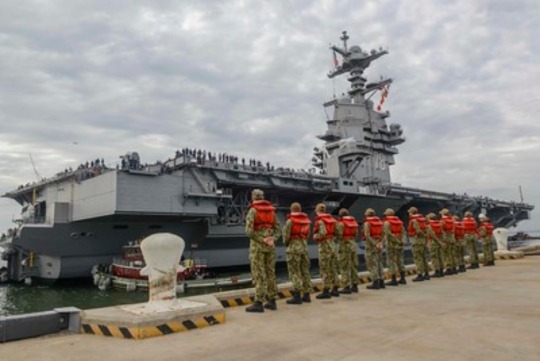
PHOTO: FLICKR/OFFICIAL U.S. NAVY PAGE
USS GERALD R. FORD (CVN 78)
The nuclear-powered Nimitz- and Ford-class carriers are designed for a 50-year service life with a single mid-life refurbishing necessary during that long life. But there are some significant differences between these two classes as well.
The USS Gerald R. Ford has two reactors that can generate 600MW of electrical power vs. the Nimitz-class ships that have one reactor that produces 200MW of electrical power. Another major difference is that the Gerald R. Ford has an electromagnetic catapult system that can generate 25% more sorties (flights) than the Nimitzes’ steam-powered catapult system. The Ford also has a dozen electromagnetic weapons elevators, which makes the movement of planes and armaments much faster and more efficient. This, again, makes the Ford capable of arming and launching more aircraft more quickly.
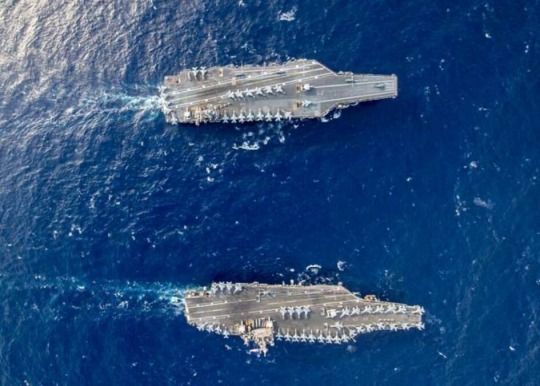
PHOTO: GETARCHIVE/DEFENSE VISUAL INFORMATION DISTRIBUTION SERVICE
THE FORD-CLASS AIRCRAFT CARRIER USS GERALD R. FORD (CVN 78) AND THE NIMITZ-CLASS AIRCRAFT CARRIER USS HARRY S. TRUMAN (CVN 75) TRANSIT THE ATLANTIC OCEAN JUNE 4, 2020.
A third difference between the Nimitz- and Ford-class carriers is that the USS Gerald R. Ford is equipped with technologically more advanced radar systems. It has an AEGIS-style X-Band AN/SPY-3 Aegis radar and S-Band Volume Surveillance Radar, capable of search, track, and multiple missile illumination. This makes it possible to detect incoming aircraft and missiles at a greater distance.
Lastly, the Gerald R. Ford also has more sophisticated defensive armaments. It has two MK.29 missile launchers with eight ESSMs each. It has two Rolling AirFrame missile launchers, as well as four Phalanx Close-In Weapons systems for defense against attacking aircraft, missiles, and small ships.

PHOTO: FLICKR/OFFICIAL U.S. NAVY PAGE
USS GERALD R. FORD (CVN 78)
Because Gerald R. Ford-class aircraft carriers are so new and so much more sophisticated than the Enterprise and Nimtz-class carriers, they have experienced a number of glitches in the various high-tech systems that have been deployed in the design. Those have been worked out, and the USS Gerald R. Ford has recently been deployed fully to the fleet and is on active duty. Those improvements will, of course, be incorporated into the two Ford-class carriers currently under construction and the third that is on order. These Ford-class carriers will eventually completely replace the former Enterprise- and Nimitz-class carriers.
These massive, fast, powerful ships will continue to be the centerpiece of the U.S. Navy’s mission for decades to come. There is nothing quite like a U.S. Navy Carrier Strike Group to protect the freedom of the seas and to deter potential adversaries from threatening that freedom.
0 notes
Text

F-14B (162691/AC112) / VF-32 "Swordsmen"/ USS Harry S. Truman (CVN-75) *Sept2005*
2 notes
·
View notes
Link
Check out this listing I just added to my Poshmark closet: Vintage USS Harry Trueman CVN 75 Snapback New Era.
0 notes
